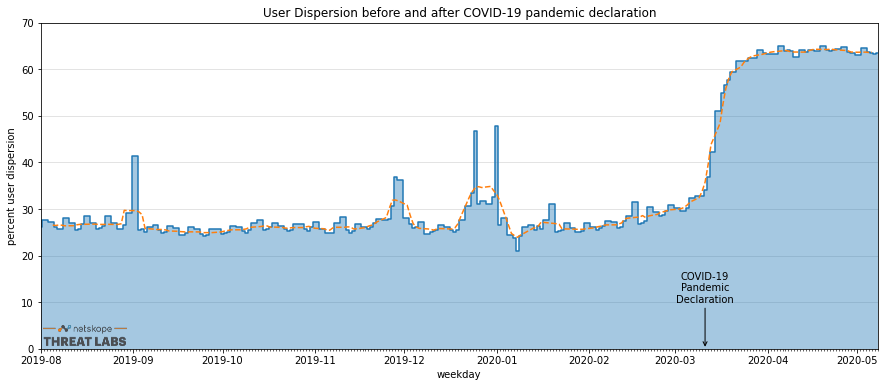2020, as a year, has been anything but predictable, but we’re proud to say we got even a few things right. Here’s a look back at some pretty big trends, a couple of things that sort of happened, and at least one big miss:
This Happened:
Remote/mobile devices will become the primary means to access enterprise data
As we noted in our original prediction, “the average worker has two or more devices they are using to access a given organization’s data,” but the remote working driven by COVID-19 has only accelerated this further. From our perspective at Netskope, we saw more than 60% of our own users working remotely as a result of COVID-19 since early March 2020, as shown in the figure below. With this rise in using remote devices, whether managed or unmanaged, to access enterprise data outside of the traditional perimeter, many organizations have even started to make exceptions for allowing mobile devices too.

Accidental exposure and misconfiguration will increase the severity and variety of breaches
As people accelerated in their shift to the cloud in response to COVID, spinning up instances of apps and adopting more storage within the cloud, the potential for accidental exposure and misconfigurations increased as well. This rise correlates with an increase of both accidental and malicious insider threats. According to the Netskope Threat Labs’ August Cloud and Threat Report, 7% of users intentionally uploaded sensitive information to personal instances of webmail and cloud storage apps. Similarly, Netskope Threat Labs also found that 14% of uploads to the Netskope Security Cloud are images that contain some form of sensitive PII. Without the proper controls and policies in place, these sorts of statistics show how much a breach of this information, whether uploaded maliciously or accidentally, could harm an organization.
The shift from legacy VPN to Zero Trust Network Access will accelerate
Zero Trust Network Access (ZTNA) became a hot topic for cybersecurity practitioners in 2020. As organizations pivoted to remote work in 2020, security teams were hit with overextended VPNs which quickly became more costly, while also serving as a hindrance to the volume of users trying to access the network. Not to mention the risk posed by the lateral full network access VPNs offer too. ZTNA then became the alternative many turned to from their VPNs. In a Cybersecurity Insiders Report, 77% of security practitioners see the value of ZTNA with other cloud security services. Not only is it the more affordable option, but it helps practitioners implement more principles of Zero Trust into their strategy, setting them up for a SASE-enabled future.
This Surprised Us:
The market evolution of SASE
While SASE was very much on the tip of every security practitioner’s tongue in 2019, even we were surprised to see just how much momentum it has built up in 2020. As practitioners see the perimeter eroding at an accelerated pace as a result of COVID, they’re starting to think more and more about a SASE-enabled future and lay the groundwork in terms of budgeting and planning. What we are seeing is organizations starting to develop SASE-enabled security strategies, converging networking and security teams, in many cases all under the CISO. Though Netskope’s CISO for EMEA Neil Thacker estimated, in his three-part blog series about the Economics of Network and Security Transformation, a transition could take anywhere from 3-5 years to fully come to fruition. While there’s still a long way to go, it is clear that the market and practitioner mindsets are shifting toward a SASE future at a rapid pace.
This Sorta Happened:
More than 50% of enterprise traffic will go to the cloud
There’s no doubt that there’s been a massive shift in traffic, as organizations have adopted cloud and Saas apps, like Zoom and DocuSign, in the face of COVID. At Netskope, we observed more than 50% of SWG traffic is related to cloud and SaaS apps. While we do expect that trend to continue increasing, as the amount of enterprise apps increases, many of those apps are likely unmanaged and outside of the visibility of enterprise IT teams, which puts data at risk. While we did see at least 50% of enterprise traffic going to the cloud, there’s likely more traffic outside of the traditional perimeter that security teams need to be aware of and work to secure as this trend continues in 2021.
This Didn’t Quite Happen:
The Data Protection market will be completely inverted:
While we’re seeing some inversion in the Data Protection market, nothing like the inversion we described has happened yet. Specifically, we predicted “enterprises will completely rethink how they approach data protection when it no longer sits within the four walls of the organization.” We also predicted that “data protection services will invert outside the traditional data center utilizing more intelligent and scalable cloud-native technologies such as Artificial Intelligence/Machine Learning.” People still want this kind of innovation that comes with inverting this market, but it is going to take much longer, likely years longer, than the year we initially projected. People are looking for a way forward in a pretty complex field. While we’re seeing some strides here at Netskope in using AI/ML for Data Protection, completely inverting the Data Protection market will likely take years to be completely inverted.




 Back
Back 





















 Read the blog
Read the blog